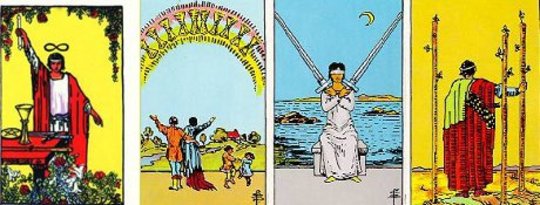
The game is about learning to recognize which aspect of your personality tends to take charge in the presence of a particular person, situation, or assignment. This can be startling, embarrassing, or confirming. It is often a game changer.
We will call this game Tarot Aspects of the Self. If new to Tarot, you want to warm up for this by doing some daily one-card draws and a little mixing and mingling with what else is in your deck. But you don’t need to take an extended course in Tarot to play the Tarot Aspects game. You do need to grasp that a pack of seventy-eight Tarot cards is composed of three minidecks: the trumps (or major arcana), the court cards, and the number cards.
The twenty-two trumps, or major arcana, represent larger, transpersonal forces at work in the world or a given situation. The sixteen court cards, in a different type of reading, may represent other individuals; in this game, they always represent aspects of you. They have different names in different decks; here we will call them king and queen, prince and princess. The court cards, like the forty number cards, belong to four suits, corresponding to four elements and four psychological functions.
In many decks the four suits are Wands, Cups, Swords, and Disks (or Pentacles). Wands are usually associated with fire and intuition, Cups with water and emotion, Swords with air and intellect, Disks with earth and sensation. In our game, the court cards will show us whether we tend to respond to a certain life theme from the head or the heart, and from a younger or more mature aspect of ourselves. The number cards, in this game, will show us the likely outcome of allowing that aspect to rule our attitudes and behavior in relation to a certain issue.
The Tarot Aspects game involves looking in a Tarot mirror at the face you reveal in relation to a life issue. As when we look in the bathroom mirror on a bad morning, the results can be shocking or sobering. Can that really be me?
Preparing the Cards to Play the Game
The first step in this game is to divide your Tarot deck into the three minidecks. This means sifting through the cards and placing the trumps in a pile to the left, the court cards in a middle stack, and the number cards in a larger pile to the right. A quick way to check whether you’ve done the division right is to count the court cards (there should be sixteen) and then, if you’re still unsure, the trump cards (twenty-two).
Your intention now is to discover what aspect of you takes charge of your personality in the presence of a certain issue or person. To set your intention, you need to name that issue or person. “Speaking in public,” “my boss,” or “my ex” might or might not be an issue for you.
Shuffle your three minidecks while focused on your issue.
Starting the Self-Discovery
 Now turn over a card from the trumps in the first pack. You can take the card at the top or pull from anywhere you like in the minideck. This card represents the larger, transpersonal forces that come into play when you are confronting your issue.
Now turn over a card from the trumps in the first pack. You can take the card at the top or pull from anywhere you like in the minideck. This card represents the larger, transpersonal forces that come into play when you are confronting your issue.
Next, turn over a court card from the second pack. This is the critical card in the reading. It shows you the aspect of yourself that takes charge of your thinking and behavior in relation to the person or issue you have identified.
Now turn over a number card from the third pack. This shows the probable outcome of letting the aspect revealed by the second card rule your personality in relation to that issue.
If you like the outcome, your reading is done. You’ll want to take note that things work out well when you are operating from a certain side of yourself, and to check where you are “at” when that issue arises again.
Changing the Outcome: Discovering a Different Aspect of Yourself
If you do not like the outcome suggested by the number card, this game gives you a chance to change it. You get to play again. Remove the court card you drew before and retire it from the game. You are now ready to see how things develop when you face an issue from a different side of yourself. However, put the outcome card back in the numbers pack. You leave the trump where it is. The transpersonal force it represents remains at play in the larger field through your personality shifts.
Reshuffle the two minidecks you’ll use this time — the court cards and the number cards. Draw a court card, noting the contrasts between this face card and the previous one. Maybe you have moved from masculine to feminine, from fiery to watery, from youthful to mature aspects of yourself.
Now pull the outcome card from the numbers deck. If you like the outcome, you’ll want to remember to call on this aspect of yourself — maybe one you hadn’t fully recognized until now — when that issue comes up.
If At First You Don't Succeed...
If you still don’t like the outcome, you get one more chance to play. You now retire the second court card you drew from the game, but place the outcome card back in the numbers deck. The rules for the third round are the same as for the second, except that if you like, you may now choose one of the court cards as the personality aspect you will consciously work with.
With your new court card showing, you draw a new outcome card from the numbers deck. If you like the outcome, think very hard about what you will do to make sure you embody the best traits of the part of you evoked by the court card that is now showing. If you still don’t like the outcome, maybe this is the time for a “cooling-off” period in relation to your issue, or to avoid pushing for change in a relationship.
Reprinted with permission of the publisher,
New World Library, Novato, CA. ©2012 by Robert Moss.
www.newworldlibrary.com or 800-972-6657 ext. 52.
This article was adapted with permission from the book:
Dreaming the Soul Back Home: Shamanic Dreaming for Healing and Becoming Whole
by Robert Moss.
 Robert Moss teaches that our dreams give us maps we can use to find and bring home our lost or stolen soul parts. We discover how to heal ancestral wounds and open the way for cultural soul recovery. You’ll learn how to enter past lives, future lives, and the life experiences of parallel selves and bring back lessons and gifts. He writes. “It’s about growing soul, becoming more than we ever were before.” With fierce joy, he incites us to take the creator’s leap and bring something new into our world.
Robert Moss teaches that our dreams give us maps we can use to find and bring home our lost or stolen soul parts. We discover how to heal ancestral wounds and open the way for cultural soul recovery. You’ll learn how to enter past lives, future lives, and the life experiences of parallel selves and bring back lessons and gifts. He writes. “It’s about growing soul, becoming more than we ever were before.” With fierce joy, he incites us to take the creator’s leap and bring something new into our world.
For More Info or to Order This Book.
About the Author

Robert Moss was born in Australia, and his fascination with the dreamworld began in his childhood, when he had three near-death experiences and first learned the ways of a traditional dreaming people through his friendship with Aborigines. A former professor of ancient history, he is also a novelist, journalist, and independent scholar. His nine books on dreaming, shamanism and imagination include Conscious Dreaming, Dreamways of the Iroquois, The Three “Only” Things, The Secret History of Dreaming, and Dreamgates: Exploring the Worlds of Soul, Imagination, and Life Beyond Death. Visit him online at www.mossdreams.com




























